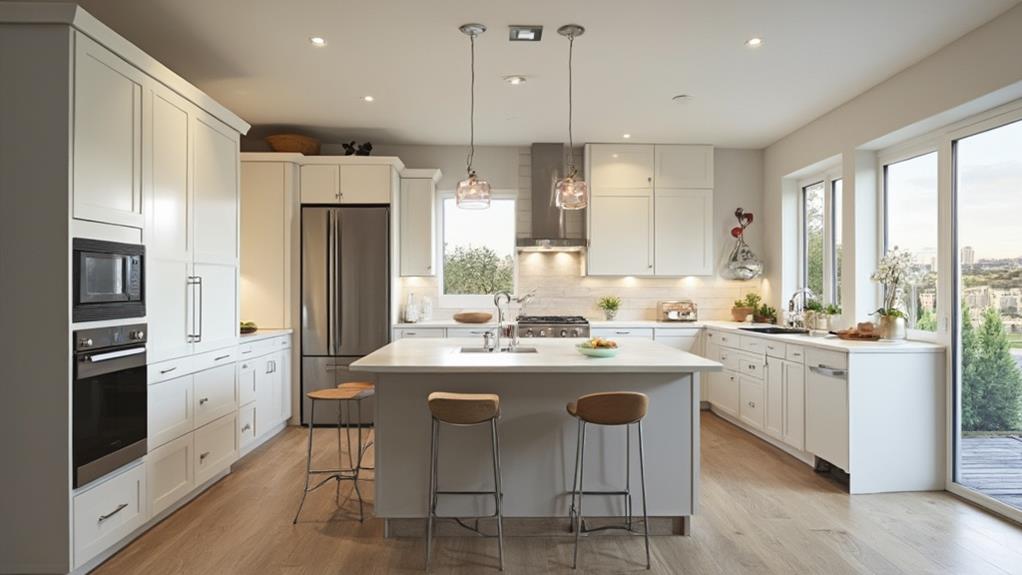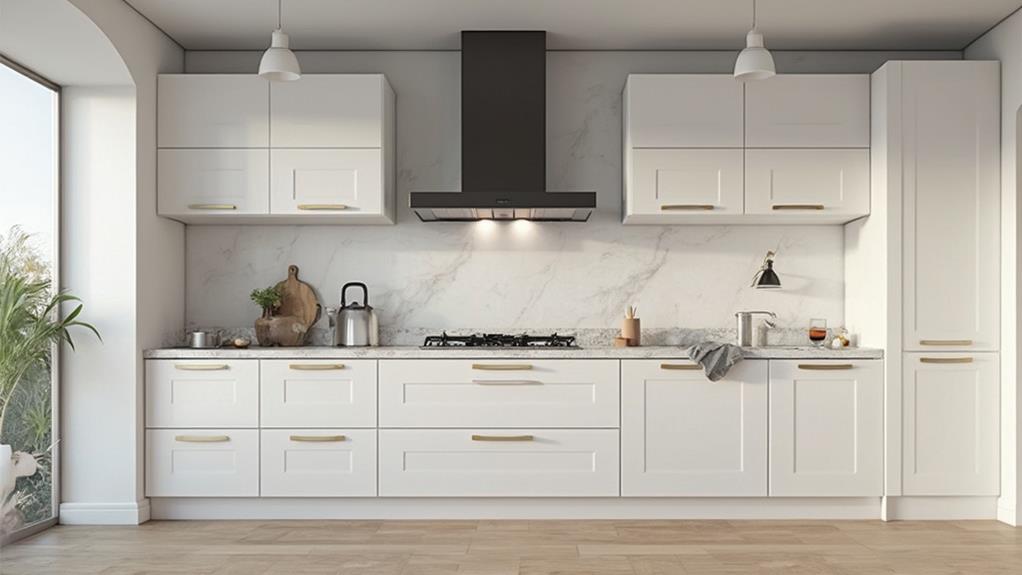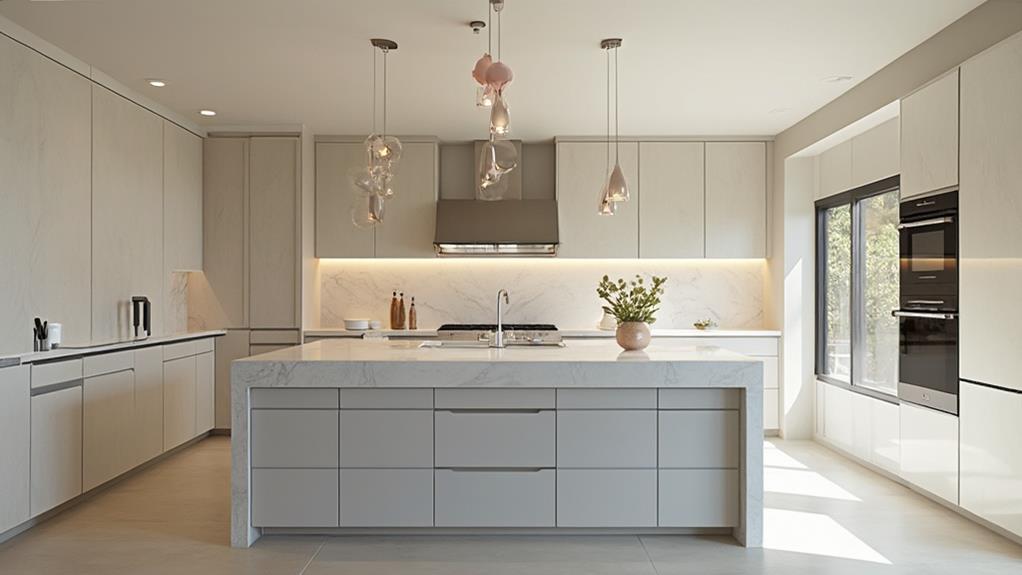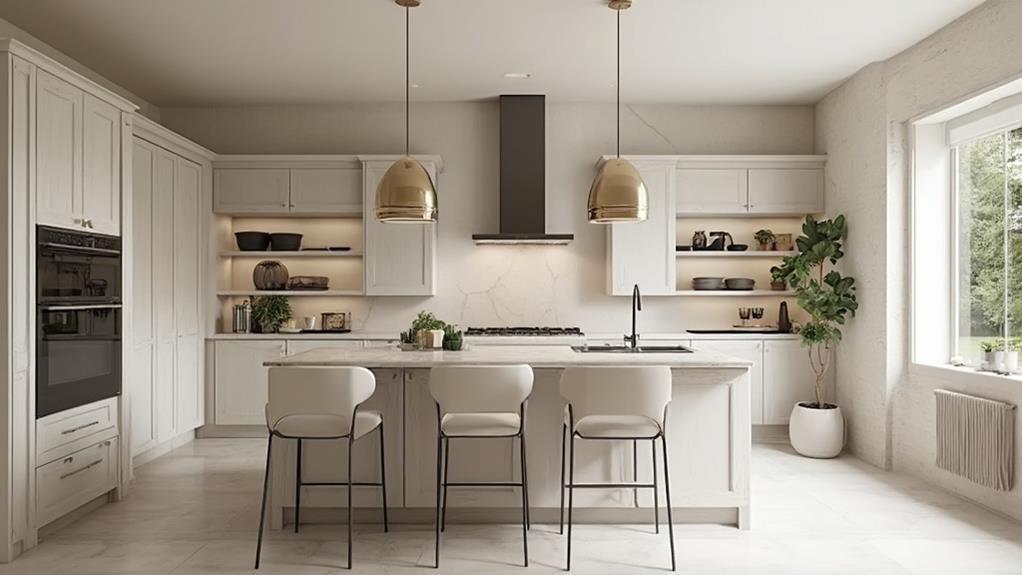Symmetry and balance in kitchen design can transform your cooking space into a harmonious and functional masterpiece. By creating visual appeal and order, you'll achieve a sense of stability in your kitchen's overall aesthetic. Consider a central focal point for arranging elements, and strike a balance between form and function. Symmetrical cabinet arrangements, thoughtful appliance placement, and well-configured countertops and islands all contribute to a cohesive look. Don't forget about lighting – it plays a crucial role in enhancing symmetry and highlighting key features. With these principles in mind, you'll be well on your way to designing a kitchen that's both beautiful and practical. The perfect blend of symmetry and functionality awaits.
Understanding Symmetry in Kitchen Design

Balancing elements in your kitchen design can create a visually appealing and harmonious space. Symmetry plays a crucial role in achieving this balance, offering a sense of order and stability to your kitchen's overall aesthetic. When you're planning your kitchen layout, consider how you can incorporate symmetrical elements to enhance its visual appeal.
Start by identifying a central focal point, such as a range hood or a window. From there, arrange cabinets, appliances, and other features evenly on either side. This doesn't mean everything must be identical, but rather that visual weight is distributed equally. For example, you might place matching upper cabinets on both sides of a centered sink.
Don't forget about vertical symmetry as well. Align cabinet heights and ensure consistent spacing between elements. You can also create symmetry through color and material choices, using similar finishes on opposite sides of the room.
While perfect symmetry isn't always possible or desirable, you can still achieve balance through asymmetrical design. This involves creating visual equilibrium using different elements that have similar visual weight. By understanding and applying symmetry principles, you'll create a kitchen that feels cohesive and well-designed.
Balancing Functionality and Aesthetics
While symmetry contributes to visual appeal, a well-designed kitchen must also be practical. You'll need to strike a balance between form and function to create a space that's both beautiful and efficient. Start by considering your daily routines and cooking habits. Place frequently used items within easy reach and organize your work zones logically.
Incorporate aesthetically pleasing elements that don't compromise functionality. For example, choose countertops that are both durable and attractive. Opt for appliances that blend seamlessly with your kitchen's style while offering the features you need. Use lighting to enhance both ambiance and task performance, combining decorative fixtures with practical under-cabinet lights.
Don't sacrifice storage for style. Utilize clever solutions like pull-out pantries, corner carousels, and vertical dividers to maximize space efficiency. Mix open shelving with closed cabinets to display decorative items while hiding clutter. When selecting materials, prioritize those that are both visually appealing and easy to clean. Remember, a truly successful kitchen design doesn't just look good; it improves your cooking experience and daily life.
Symmetrical Cabinet Arrangements

When it comes to kitchen design, symmetrical cabinet arrangements can create a sense of order and visual harmony. You'll find that this approach involves balancing the placement of cabinets on either side of a focal point, such as a window or range hood. By mirroring cabinet sizes and styles, you'll achieve a cohesive look that's pleasing to the eye.
To implement symmetrical cabinet arrangements, start by identifying your kitchen's central feature. Then, work outwards, placing matching cabinets on each side. You can use a combination of upper and lower cabinets, ensuring they align perfectly. Don't forget to consider the placement of appliances and fixtures to maintain the symmetry.
While symmetry offers a classic appeal, it's essential to avoid rigidity. You can introduce subtle variations in cabinet hardware or incorporate open shelving to break up the monotony. Remember that perfect symmetry isn't always possible or desirable in every kitchen layout. In such cases, aim for visual balance by using similar cabinet styles or colors on opposing walls. This approach will help you create a harmonious kitchen design that feels both organized and inviting.
Appliance Placement for Harmony
For a harmonious kitchen design, strategic appliance placement is key. You'll want to consider the kitchen work triangle, which connects your refrigerator, stove, and sink. This triangle should be unobstructed and measure between 13 and 26 feet in total.
Place your refrigerator near the kitchen entrance for easy access, and position your dishwasher close to the sink for efficient loading and unloading.
When it comes to your oven and cooktop, consider installing them along the same wall or in an island to create a cohesive cooking zone. If you have a microwave, place it at eye level or in a lower cabinet for convenience and safety.
Don't forget about small appliances like coffee makers and toasters; designate a specific area for these to keep your countertops clutter-free.
Balance is crucial in appliance placement. If you have a large refrigerator on one side of the kitchen, consider placing your oven or a tall pantry on the opposite side to create visual equilibrium. By thoughtfully arranging your appliances, you'll create a functional and aesthetically pleasing kitchen that's a joy to work in.
Countertop and Island Configurations

Moving from appliance placement to the heart of kitchen functionality, countertops and islands are central to your kitchen's design and workflow. When configuring these elements, consider both aesthetics and practicality.
For countertops, aim for continuous, uninterrupted surfaces that provide ample workspace. L-shaped or U-shaped configurations maximize corner space and create a natural flow.
Islands can serve multiple purposes: extra prep space, casual dining, or a social hub. Ensure there's at least 36 inches of clearance around the island for easy movement. If you're incorporating a sink or cooktop, factor in additional space for safety and functionality.
For symmetry, align your island with other key elements like the main sink or range. You can create visual balance by matching the island's width to nearby cabinets or windows. Consider varied heights for different functions – a lower section for baking, a raised bar for seating.
Material choices impact both looks and functionality. Combine materials like wood and stone for visual interest, but ensure transitions are smooth. Don't forget about storage – incorporate drawers, shelves, or cabinets into your island design for maximum efficiency.
Lighting and Symmetry Interplay
Balancing lighting and symmetry, you'll create a harmonious kitchen design that's both functional and visually appealing. Start by considering the natural light sources in your kitchen and how they interact with your layout. Position key elements, like the sink or island, to maximize natural light exposure.
Incorporate symmetrical lighting fixtures to enhance the overall balance. Pendant lights over an island or dining area can serve as focal points while providing task lighting. Ensure they're evenly spaced and aligned with other design elements.
Use under-cabinet lighting to illuminate workspaces and create a sense of depth. Install them uniformly across all cabinets to maintain symmetry. Recessed ceiling lights should be arranged in a grid pattern for a clean, organized look.
Don't forget about accent lighting to highlight architectural features or display areas. Use wall sconces or LED strips to create symmetrical light patterns that complement your kitchen's design.
When selecting light fixtures, choose styles that mirror your kitchen's aesthetic. Matching finishes and shapes will reinforce the symmetrical feel. Remember, the interplay between lighting and symmetry can dramatically impact your kitchen's atmosphere and functionality.
Conclusion
You've explored how symmetry and balance can transform your kitchen from chaotic to harmonious. Remember, "a place for everything and everything in its place" isn't just an old saying—it's a design principle. By carefully arranging cabinets, appliances, and lighting, you'll create a space that's both functional and visually appealing. Whether you prefer perfect symmetry or balanced asymmetry, these concepts will help you craft a kitchen that's a joy to cook and live in.

